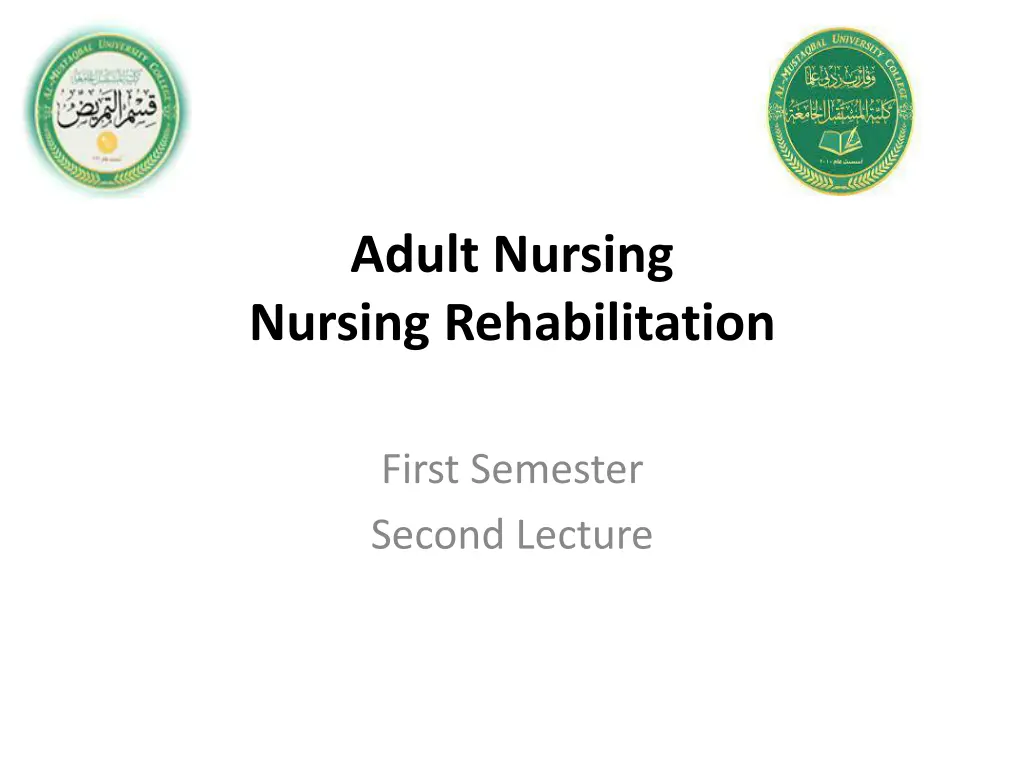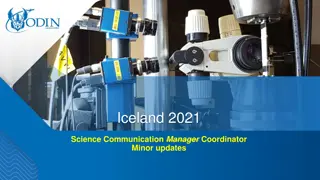
Understanding Rehabilitation in Adult Nursing: Principles and Objectives
Learn about the dynamic process of rehabilitation in nursing, focusing on defining rehabilitation, factors affecting it, basic principles, and stages of injury treatment. Understand how age, injury severity, education level, economic status, team support, and legislation impact the rehabilitation process.
Download Presentation

Please find below an Image/Link to download the presentation.
The content on the website is provided AS IS for your information and personal use only. It may not be sold, licensed, or shared on other websites without obtaining consent from the author. If you encounter any issues during the download, it is possible that the publisher has removed the file from their server.
You are allowed to download the files provided on this website for personal or commercial use, subject to the condition that they are used lawfully. All files are the property of their respective owners.
The content on the website is provided AS IS for your information and personal use only. It may not be sold, licensed, or shared on other websites without obtaining consent from the author.
E N D
Presentation Transcript
Adult Nursing Nursing Rehabilitation First Semester Second Lecture
Objectives Define the rehabilitation Identify the factors effect on rehabilitation and the basic principle of rehabilitation Recognize the types of rehabilitation. Team of rehabilitation Numerate the level of prevention
Rehabilitation : is a dynamic, health-oriented process that helps ill people or people with physical, mental, or emotional disabilities (restrictions in performance or function in everyday activities) to achieve the greatest possible level of physical, mental, spiritual, social, and economic functioning.
Factors Affected in Rehabilitation: 1. Age: The patient's age may affect his / her understanding and involvement in rehabilitation activities. 2. Severity of injury: in light of which the rehabilitation program is dedicated. 3. The level of education to the patient. 4. The economic situation and bearing the expenses and burdens of rehabilitation. 5. Provide the appropriate rehabilitation facilities of specialized Rehabilitation Team and devices. 6. Legislation and laws guaranteeing the rights of the patient who needs rehabilitation and removal of obstacles that hinder the rehabilitation process.
Basic principle in Rehabilitation Nursing The 4 principled stages of injury treatment and rehabilitation: Pain Movement Strength Function
1. Reduce Pain. It's impossible to get good results from any rehabilitation program before relief the pain first. Therefore it is a priority to reduce pain as much and as soon as possible. This can be achieved in a variety of ways whether it be drugs, ice, heat or rest amongst other means. 2. Improve Movement. Once pain is under control it is vital, as soon as possible, to regain normal movement. This will prevent many complications occurring that can affect the circulation, joints and muscles.
3. Regain Strength. This refers to the process of exercising surrounding and associated muscles to maintain, regain or improve their strength. This is so they work effectively and do not waste or atrophy 4. Improve Function. It is concerned with bringing the results of the previous stages into play to execute the desired result of functional activity. Jumping to this stage and moving through it too fast is the cause of many re-injury situations.
Types of Rehabilitation 1. Physical rehabilitation is used for patients who have suffered from bone and muscle injuries. The rehabilitation program consists of exercises (strengthening and /or stretching), stair climbing, gait (walking) training with or without assistive devices such as canes, walkers, crutches, to improve balance and endurance activities and patient family education. Rehabilitation: This sort of
2. Occupational Rehabilitation: This particular type of Rehabilitation is for those patients with a paralytic stroke or any unfortunate major accident. , It consists of strengthening muscles, improving range of motion and coordination increasing work tolerance and physical activity endurance.
3. Aquatic Rehabilitation: This is a new trend in rehabilitation yet it is a successful in treating problems in joints. The therapists treat the patients by giving various water exercises like swimming, water aerobics, etc. This helps in giving strength, flexibility and mobility to the muscles of legs.
4. rehabilitation is given to patients who have suffered from brain injury. To help them to get back to routine activities, they are treated with the help of neuropsychological approach. 5. Social rehabilitation: rehabilitation focused on maximizing personal independence and returning patients home as quickly and safely as possible. Cognitive Rehabilitation: This type of This type of
6. Vocational Rehabilitation (VR) is a federal- state program that works with people who have physical or mental disabilities to prepare for, gain or retain employment. VR is committed to helping people with disabilities find meaningful careers.
The Rehabilitation Team 1. The patient: is a key member of the rehabilitation team. The patient is the focus of the team's effort and the one who determines the final outcomes of the process. 2. Nurses : provide the patient with 24-hour-a-day nursing care. Rehabilitation nurses encourage patients to do as much of their own care as functionally possible, since the goal is to teach independence and challenge each patient to achieve their maximum potential. The nurse acts as a caregiver, teacher, counselor, patient advocate, case manager, and consultant.
3. Physiatrists: are the main medical doctor on the rehabilitation team. The physiatrist assesses patients at admission to rehabilitation and directs the patient's medical care. 4. Neuropsychologists: Their role on the rehabilitation treatment team is to address psychological needs and concerns, helping patients and families adjust to changes in their life.
5. treatment and therapy programs to help patients gain greater mobility, performance, and joint motion and balance. They also work with patients to improve their ability to perform daily activities. 6. Occupational Therapists: work with patients to regain, develop, and build skills that are important for independent functioning, health, well- being and security. Treatment focuses on helping individuals regain greater independence with activities for daily living. Physical Therapists: provide assessments, muscle strength and
7. Speech Therapists Evaluate speech and language, memory, problem- solving, hearing and swallowing skills in order to develop a treatment plan for improving problems related to a patient's injury or illness. Treatment may focus on expressive language (talking, naming, writing), receptive language (understanding and reading), swallowing, and/or diet recommendations. 8. Dietitians supervise methods of feeding and caloric needs, and monitor feeding tolerance to assure patients receive adequate nutrition.
Accreditation of Rehabilitation Facilities (CARF) sets standards for these programs and monitors compliance with the standards. 1. Stroke recovery programs and traumatic brain injury rehabilitation. Emphasize cognitive remediation, helping patients compensate for memory, perceptual, judgment, and safety deficits as well as teaching self-care and mobility skills. Other goals include helping patients swallow food safely and communicate effectively.
2. Spinal cord injury rehabilitation programs: Integral components of the programs include understanding the effects and complications of spinal cord injury; neurogenic bowel and bladder management; sexuality and fertility enhancement; self-care, including prevention of skin breakdown; bed mobility and transfers; and driving with adaptive equipment. The programs also focus on vocational assessment, training, and reentry into employment community. and the
3. Orthopedic rehabilitation programs The goals include pain management, energy conservation, and joint protection. Patients undergoing joint patients with arthritis. Learning to be independent with prosthesis or a new joint is a major goal of these programs. 4. Cardiac rehabilitation for patients who have had myocardial infarction emphasis monitored, progressive counseling; stress management; sexuality; and risk reduction. replacements and is placed nutritional on exercise;
5. Pulmonary rehabilitation programs. Respiratory therapists help patients achieve more effective breathing patterns. The programs also teach energy conservation techniques, self- medication, and home ventilatory management.
6. Comprehensive pain management programs are available for people with chronic pain, especially low back pain. These programs focus on alternative pain exercise, supportive counseling, and vocational evaluation. 7. Comprehensive burn rehabilitation programs This program focused on progressive joint mobility, self-care, and ongoing counseling is imperative for burn patients. treatment modalities,
8. Pediatric rehabilitation programs: meet the needs of children with developmental and acquired disabilities, including cerebral palsy, spina bifida, traumatic brain injuries, and spinal cord injuries. 9. Prevention of complications and deformities.
Levels of Prevention 1. Primary -concerned with health promotion activities that prevent the actual occurrence of a specific illness or disease 2. Secondary -promotes early detection or screening and treatment of disease and limitation of disability. This level of prevention is also called HEALTH MAINTENANCE. 3. Tertiary -directed rehabilitation of a disease or condition after the disease has been developed. towards recovery or
The goals of tertiary prevention are: prevent damage and pain from the disease slow down the disease Prevent the disease from causing other problems ( called "complications.") Give better care to people with the disease. Make people with the disease healthy again and able to do what they used to do.






















